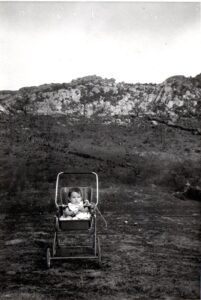I saw it for the first time in the summer of ’83.
That summer, a terrible and enormous fire had burnt the entire dense forest surrounding ‘Stazzo la Cerra’. It was only at this cost that I had become aware of the existence of a path that went straight up from the house to the ‘Sarra di lu Tassu’. A snake built in the midst of granite chaos. Some stones had been moved to facilitate the passage of people. The landscape around was almost unreal: beautiful because of the ancient rock of Sardinia, and at the same time devastated, because of that fire that swept across the plateau in July of that year, and that costed the lives of nine people in the countryside of Tempio Pausania. But the thing that had struck me the most, as I walked across it for the first time, were the round terraces built of stones and soil in the most unthinkable places.
I wasn’t understanding.
I asked the elders of the nearby stazzi.
They were ‘chei’, a word that in Gallurese means ‘charcoal kilns’.
Starting in the second half of the 19th century, the incessant demand for charcoal that followed the first industrial revolution brought teams of Tuscan charcoal burners, and later also the inhabitants of the stazzi themselves, to exploit the forest resources for the production of wood. The combustion of that wood, indeed, would lead to the creation of charcoal. How? With two simple steps: first, many plants and trees were cut down, inevitably leading to a profound transformation of the surrounding vegetation. Secondly, the wood was burnt and thus the vegetable charcoal was obtained following a meticulous production technology that remained mostly unchanged since Roman times. The combustion took place in the ‘chei’, the artificial and perfectly flat terracings located along the forest land. This is where the production of charcoal has taken place: a special structure, conical in shape, was built, raised up by by the overlapping of logs and logs of wood. This structure was then insulated with a double cover of grass and earth. Once the combustion started from inside the ‘chea’ through a hole in the top of the pile, it was fed every 12 to 15 hours, by inserting burning embers inside and also opening vents along the walls that acted as vents. The charring process lasted, depending on the size of the charcoal pile, between 10 and 15 days, and ended with the fire being smothered, the charcoal pile being dismantled and the charcoal being removed. This difficult and laborious procedure thus led from the initial 100 quintals of wood to around 20 quintals of coal.
During the Christmas 2020 shutdown period due to the Coronavirus pandemic, together with the whole family and our friend Augusto Morbidux, a keen Gallura connoisseur and explorer, we began clearing the steep path of weeds and cleared the undergrowth to encourage the slow regrowth of valuable essences (holm oaks, ash trees, cork trees, strawberry trees, alaternus and filirree). It was an hard and tiring work, but also exciting and rewarding, and in the end it led to the discovery of no less than 15 ‘chei’. Eventually, we positioned the signposts to simplify the path for our guests on the farm and to hiking lovers.


